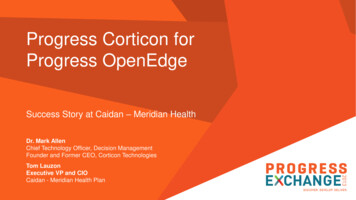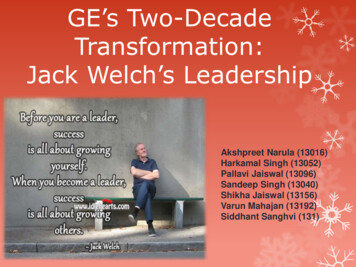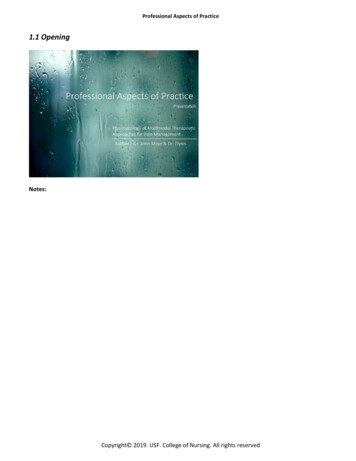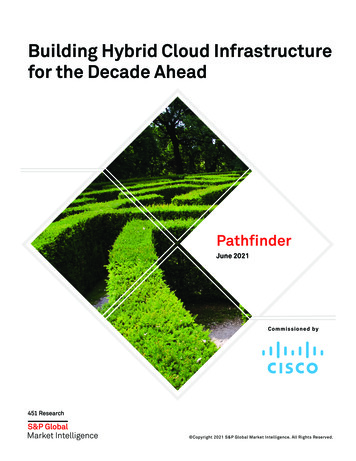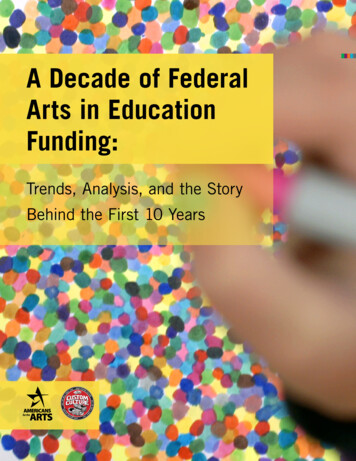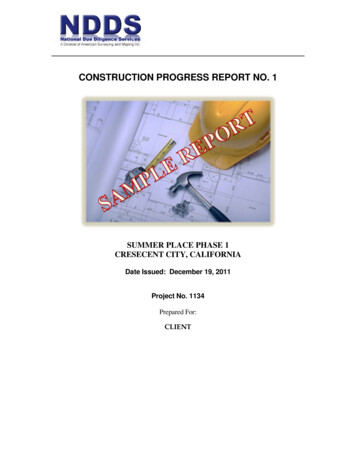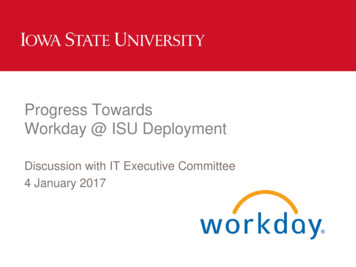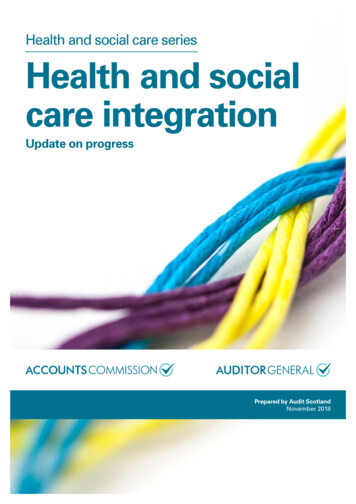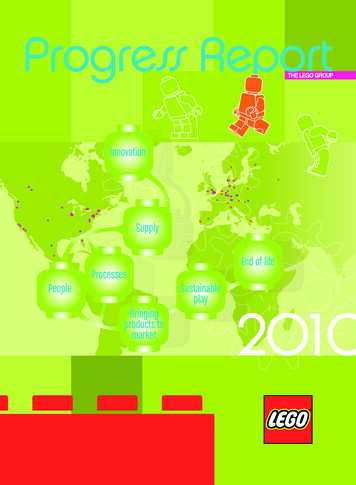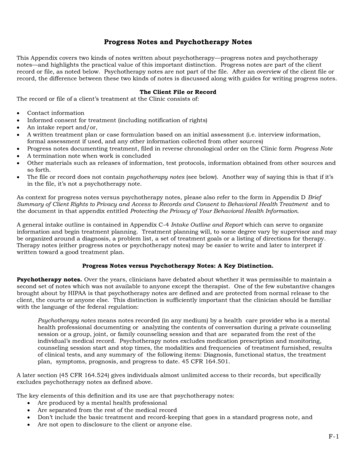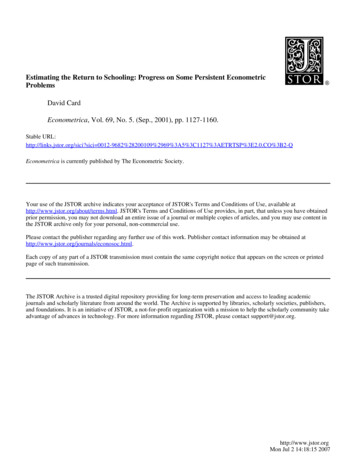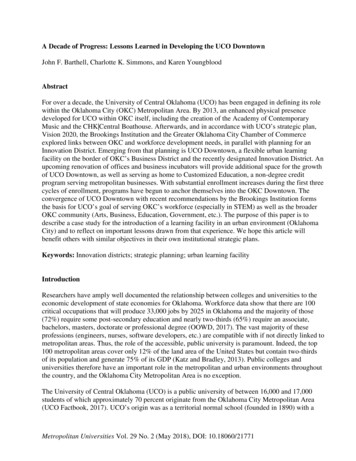
Transcription
A Decade of Progress: Lessons Learned in Developing the UCO DowntownJohn F. Barthell, Charlotte K. Simmons, and Karen YoungbloodAbstractFor over a decade, the University of Central Oklahoma (UCO) has been engaged in defining its rolewithin the Oklahoma City (OKC) Metropolitan Area. By 2013, an enhanced physical presencedeveloped for UCO within OKC itself, including the creation of the Academy of ContemporaryMusic and the CHK Central Boathouse. Afterwards, and in accordance with UCO’s strategic plan,Vision 2020, the Brookings Institution and the Greater Oklahoma City Chamber of Commerceexplored links between OKC and workforce development needs, in parallel with planning for anInnovation District. Emerging from that planning is UCO Downtown, a flexible urban learningfacility on the border of OKC’s Business District and the recently designated Innovation District. Anupcoming renovation of offices and business incubators will provide additional space for the growthof UCO Downtown, as well as serving as home to Customized Education, a non-degree creditprogram serving metropolitan businesses. With substantial enrollment increases during the first threecycles of enrollment, programs have begun to anchor themselves into the OKC Downtown. Theconvergence of UCO Downtown with recent recommendations by the Brookings Institution formsthe basis for UCO’s goal of serving OKC’s workforce (especially in STEM) as well as the broaderOKC community (Arts, Business, Education, Government, etc.). The purpose of this paper is todescribe a case study for the introduction of a learning facility in an urban environment (OklahomaCity) and to reflect on important lessons drawn from that experience. We hope this article willbenefit others with similar objectives in their own institutional strategic plans.Keywords: Innovation districts; strategic planning; urban learning facilityIntroductionResearchers have amply well documented the relationship between colleges and universities to theeconomic development of state economies for Oklahoma. Workforce data show that there are 100critical occupations that will produce 33,000 jobs by 2025 in Oklahoma and the majority of those(72%) require some post-secondary education and nearly two-thirds (65%) require an associate,bachelors, masters, doctorate or professional degree (OOWD, 2017). The vast majority of theseprofessions (engineers, nurses, software developers, etc.) are compatible with if not directly linked tometropolitan areas. Thus, the role of the accessible, public university is paramount. Indeed, the top100 metropolitan areas cover only 12% of the land area of the United States but contain two-thirdsof its population and generate 75% of its GDP (Katz and Bradley, 2013). Public colleges anduniversities therefore have an important role in the metropolitan and urban environments throughoutthe country, and the Oklahoma City Metropolitan Area is no exception.The University of Central Oklahoma (UCO) is a public university of between 16,000 and 17,000students of which approximately 70 percent originate from the Oklahoma City Metropolitan Area(UCO Factbook, 2017). UCO’s origin was as a territorial normal school (founded in 1890) with aMetropolitan Universities Vol. 29 No. 2 (May 2018), DOI: 10.18060/21771
role that extended across the territory in teacher preparation (Loughlin & Burke, 2007). Over theyears, the mission and niche of UCO has evolved with the growth of Oklahoma City andsurrounding environs to produce a much broader array of degree programs, including masters andprofessional degrees outside of teacher preparation. Through time, given its close proximity toOklahoma City (OKC), UCO is now widely recognized as the public metropolitan university forOKC as recently stated on social media by Mayor Mick Cornett: “With the ACM@UCO inBricktown, downtown classes at the Carnegie Building, and the UCO Boathouse in the BoathouseDistrict, UCO has a substantial OKC footprint” (Cornett, 2017).This article will demonstrate how, given a strategic commitment to being a metropolitan university,the University of Central Oklahoma created a successful learning center (UCO Downtown) in theheart of Oklahoma City. We will describe the process that led to the physical creation of the centeras well as local, regional, and national policies that influenced it. Our hope is that this case study willbenefit those wishing to create similar outcomes for their metropolitan planning initiatives.The First StepsThe Academy of Contemporary Music (ACM) began enrolling students in the fall of 2009. Theprogram occupies a former 25,000 square foot warehouse building in the now attractiveentertainment district known as Bricktown. The program provides Associates and/or Bachelorsdegree options, and its curriculum focuses on contemporary music performance, production andtechnologies. ACM currently enrolls several hundred students and has shown marked resiliencyduring the recent economic downturn in Oklahoma (UCO Factbook, 2017). For UCO, ACMrepresents the first attempt to bring a niche program, relevant to an urban environment, to downtownOklahoma City. An in-resident CEO manages the program independently of the main campus, butadheres to the academic guidelines of the College of Fine Arts and Design. ACM also operates anearby Performance Lab that is used for live performances of faculty, students, staff, and guestperformers.The Central/CHK Boathouse opened in the spring of 2015 and serves the UCO Women’s rowingteam as well as serving as a venue for live music, art exhibitions, and conferences. The facility wasfunded entirely by private sources and generates annual income (through rental fees for events) tooffset maintenance costs. The Boathouse is adjacent to the Oklahoma River and a part of theBoathouse District that serves as a new and attractive community aquatics center for the OklahomaCity Metropolitan Area as well for competitive rowing teams that use the river because of its uniquegeometry. While no courses or academic programs are offered at the Boathouse, the facility hasbecome a popular location to host visiting delegations and for planning retreats as well as a settingfor fundraising events.After the culmination of the Vision 2020 planning process in the spring of 2013, and a Division ofAcademic Affairs planning process in the following fall semester of 2013, the need to create aphysical connection to Oklahoma City emerged as a key priority. Several investigatory expeditionsbegan in order to locate an appropriate and affordable teaching space within Oklahoma City.Ultimately, the historical Carnegie Metropolitan Library building was designated for housing thisteaching effort, as described in a later section. A plan took shape to support the design andconstruction of a teaching facility there. Critical to this effort was collaboration with the Center for58
e-Learning and Connected Environments (CeCE), the key organization on the UCO campus thatprovides professional expertise in learning design to faculty and staff members.Vision 2020 and the Commitment to the Oklahoma City Metropolitan AreaIn 2011, with the arrival of a new president, Dr. Don Betz, UCO had its first institution-wideplanning process (inclusive of all faculty and staff) since 2007 and produced four strategic themes:(1) Transformative Learning; (2) Student Success; (3) Value; and (4) Place. Below, we describethese themes and their relevance to our strategic planning process.Transformative Learning. Transformative Learning (TL) activities on our campus include importantemphases that are relevant to UCO’s role in the Metropolitan Area, including Civic Engagement andService Learning, among others (Barthell et al., 2010). These activities even operate to support thecareer aspirations of our students through an e-portfolio system, known as the StudentTransformative Learning Record or STLR, which records contributions of our students in all areas ofTL (Barthell et al., 2014). The last of these themes, Place, affirmed the intertwining roles of historyand locale with an explicit connection to the Oklahoma City Metropolitan Area.Student Success. TL activities on the UCO campus conform well with High-Impact EducationalPractices that are known to promote student success (Kuh, 2008, Cunliff & Hughes, 2011). In 2014,UCO established an Office of High-Impact Practices to promote further this connection betweenstudents and these important learning experiences (Springer et al., 2018). Combined with theopportunities presented by the STLR system (Barthell et al., 2010), student opportunities may reachwell beyond their undergraduate years and into their later careers.Value. Vision 2020 also emphasizes the value of an education at UCO and the ability for students toachieve access to that education on our campus. Access includes a commitment to diversity andinclusion as well as finding mechanisms for making that education accessible to students fromchallenging socio-economic backgrounds. Key to this commitment is an understanding of the role ofwidening the “band width” of students entering college for the first time (Verschelden, 2018).Place. UCO’s roots as a teaching institution inform its sense of being student-centered. As ametropolitan university with a commitment to the people in and around the Oklahoma CityMetropolitan Area, its commitment must manifest in both physical and cultural terms. This includesthe case study described in this article, as well as examples of outreach to community members inOklahoma City itself that have been a critical part of our strategic planning process by helping torealize the community connections elucidated through the Vision 2020 planning process. Forexample, UCO began a formal collaboration with the Greater Oklahoma City Hispanic Chamber ofCommerce in 2014. UCO is currently represented by one member of the Chamber’s Board ofDirectors and at least one staff member (Director of Community Outreach) is housed part-time at theChamber’s headquarters. UCO’s Division of Student Affairs conducts student recruitment there inthe evenings, as well as outreach events that support the Hispanic Community. UCO works closelywith the Chamber in both staff and faculty leadership development, including through the LatinoLeadership OKC program.The Innovation District59
Simultaneous with the development of UCO Downtown, discussions within the UCO President’sCabinet began to focus on broader patterns associated with successful collaborations amonguniversities and other elements of urban communities. Indeed, in an era of declining state support forpublic universities, the importance of localized (municipal and community) support in strengtheningthe role of universities has become an even more important aspect of strategic planning andinstitutional investment patterns. UCO has therefore begun a reconceptualization of its role to alignits resources and programming with community assets and needs to increase its regional relevancefor the Oklahoma City Metropolitan Area. Key to that role is an enhanced footprint withinOklahoma City itself.In their book Metropolitan Revolution, published in 2013, coauthors Bruce Katz and JenniferBradley stated, “Innovation Districts cluster and connect leading-edge anchor institutions and cuttingedge innovation firms with supporting and spin-off companies, business incubators, mixed-usehousing, office and retail, and twenty-first century amenities and transport.” Bruce Katz visited theUCO campus in February of 2015 as an invited speaker for the celebration of UCO’s 125thanniversary. During that time, he visited with members of senior leadership at UCO and theOklahoma City Chamber of Commerce and proposed that the ideal location for an InnovationDistrict (ID) would be along an area bisected by Interstate 235 (I-235). The eastern side of the area iscomposed of universities, research foundations, and numerous business enterprises attractive toentrepreneurs. On the western side of I-235 is an area that is replete with restaurants and coffeeshops that are in close proximity to museums, theatres, and performance halls on the western side ofI-235 in a section of Oklahoma City known as Automobile Alley.In the following fall of 2015, Oklahoma City and Philadelphia were the only two of dozens ofcandidate cities to gain admission in the Anne T. and Robert M. Bass Initiative on Innovation andPlacemaking. The Oklahoma City Chamber of Commerce then entered into a contract with theBrookings Institution to recommend an exact area for the District, conduct an economic ecosystemaudit of the proposed location, and recommend steps for implementing the ID. Brookings hasalready delivered its recommended area for the ID and it encompasses 843 acres, bisected byInterstate 235 (I-235) as described above. This represents only 0.2% of the area of Oklahoma Citybut it accounts for 4.7% of its jobs. A research park dominates the area to the east of I-235. The parkis composed of private and state-funded institutions, which, for the most part, advance economicinterests in biomedical research and the health industry. (The number of jobs in the ID that areSTEM-related is 28%, compared to only 16% of those in Oklahoma City as a whole.) The area to thewest of I-235 concentrates most of the residents of the innovation district. As noted above, the areaserves as a magnet for entertainment and dining opportunities for people throughout the OklahomaCity Metropolitan Area.UCO has been a participant in all segments of planning for the Oklahoma City ID. A teachingfacility, UCO Downtown (in the former Carnegie Metropolitan Library building), developed as theID was still in its planning infancy. UCO Downtown aligns with UCO’s Vision 2020 as UCO’s firstattempt to bring core programs (especially graduate programs) into the downtown Oklahoma Cityenvironment. Indeed, planning for the facility occurred during the Fall 2013 Academic AffairsRetreat while senior leadership (deans and cabinet members) were reading the newly publishedMetropolitan Revolution by Katz and Bradley (2013). UCO Downtown took its first students during60
the spring semester of 2015. Additional programs have developed since the emergence of the ID inOklahoma City include those associated with the Office of Customized Education. Initiated in thedowntown area in 2016, in a building about three blocks from UCO Downtown, CustomizedEducation exists to integrate business and entrepreneurial activities created in the ID with UCOprograms that can contribute to such entrepreneurship. Still nascent, Customized Education will soonbe housing businesses that are collaborating with UCO on innovative projects with promise asmetropolitan business partners.UCO Downtown: The JourneyIn search of UCO’s next foray into the heart of the Oklahoma City metropolitan area, the Deans andPresident’s Cabinet had numerous Friday afternoon excursions to downtown Oklahoma City,trudging through unfinished and darks spaces in buildings it appeared we would be able to afford torent. After more than a year of searching, we found “the right place at the right price” in theCarnegie Centre, the former home of Oklahoma City’s Metropolitan Library from 1901 until 2004.The building had been vacant since 2004 when the new downtown library opened as part of theoriginal Metropolitan Area Projects (MAPS) plan, a capital improvement program funded by atemporary sales tax.While her initial plans for the empty building had been an extensive reconfiguration and conversioninto upscale condominiums, developer Judy Hatfield held on to the Carnegie Centre during the 2008economic downturn and waited for better times. Utilizing tax credits for the historic building andTax Increment Financing (TIF) investment opportunity, she was able to re-open the Carnegie Centrein 2014 with commercial spaces on the ground floor and 19 apartments on the upper floors(Lackmeyer, 2014).Stepping into an elevator with a display of vintage book binders still lining its walls, reminiscent ofthe former use of the building, visitors descend one floor to get a view of the space that was leased inthe newly renovated Carnegie Centre in July 2014. While at first glimpse one previously saw only adark and cold basement with no plumbing and devoid of HVAC and lighting fixtures (see Figure 1),President Don Betz agreed that the empty shell of a space allowed us to imagine new possibilities.Consistent with President Betz’s frequent characterization of the university community as being“idealist[s] without illusions,” we weighed the risks versus rewards and became the signature tenantthe landlord was seeking to grow momentum for the property. “UCO Downtown” (see Figure 2) hadfound a home in a signature multi-use building in a well-established area of the central businessdistrict.61
Figure 1. First view of the lower level of the Carnegie CentreFigure 2. Carnegie Center, home of the UCO Downtown teaching facilityOnce we decided to lease the space, we set in motion our plans to open for classes in time forJanuary (2015) classes. After quick concept-to-architectural drawings, in October of 2014, the wallsstarted going up to define the space. By November, the HVAC and sheetrock were in place, andDecember saw a frenzied final month of construction to completion (see Figures 3 and 4). After atest run in early January with a one-week Intersession class, the building was ready for a silentopening for the spring 2015 semester.62
Figure 3. Construction as the walls begin to define the spaceFigure 4. Construction as the HVAC goes inThe UCO Downtown teaching facility was designed to be different: a space appropriate for an urbansetting location with a layout that maximizes flexibility and collaboration. It was to have sixclassrooms with flexible furniture sufficiently adjustable so that a given room could be quickly setup to accommodate a multitude of requests. It could accommodate a yoga class at the beginning ofthe day, a corporate retreat during the daytime hours, a community lunch-and-learn over the lunchhour, and reset for credit-bearing classes in the evening (see Figures 5–7).63
Figure 5. UCO Downtown classroom sample configurationFigure 6. UCO Downtown classroom sample configuration64
Figure 7. UCO Downtown classroom set for an evening eventPlanners installed collaborative-learning spaces throughout the teaching facility. Space is availablefor students to work independently or in groups and provides a convenient location for students togather before and after classes (see Figures 8–10). With an excellent restaurant directly across thestreet from the facility, downtown workers may arrive early, have dinner, and then prepare for class.Figure 8. Collaborative space with “whiteboard” tables65
Figure 9. Collaborative space for individual or group workFigure 10. Areas for students to study before and after classesOne of the most unique and customer-focused approaches of the facility is the “techceptionist.”These student employees, trained to handle all of the technology needs of the facility, serve as thefirst point of contact and reception for the space. UCO Downtown classrooms are equipped with themost up-to-date technology of any UCO facility, including interactive video capability for distancelearning. With a goal “to do everything but teach,” techceptionists handle all technology concerns, inorder to create an environment that is conducive to learning and assure the overall teachingexperience is a pleasant one for faculty.66
UCO contracted with a downtown parking garage to provide parking for students and faculty threeand one half blocks “near” the facility. Parking is currently provided for free, a feature whichstudents enjoy (see Figure 11). UCO Downtown is unique to UCO and to downtown OKC and, asdetailed below, has become a favorite place for classes for many faculty and students.Figure 11. Reasons why students love UCO DowntownIf you build it, will they come?Eve
The University of Central Oklahoma (UCO) is a public university of between 16,000 and 17,000 . surrounding environs to produce a much broader array of degree programs, including masters and professional degrees outside of teache
